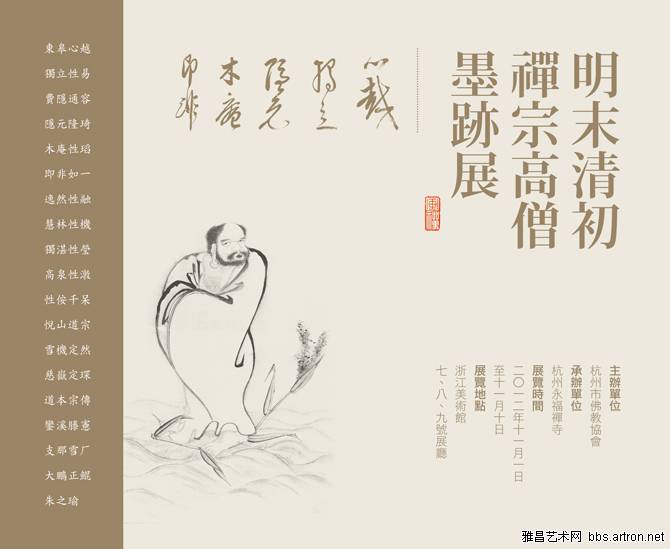Prof. Yang Kuei-hsiang kindly shared with me President Xi's address in Japanese translation. The paragraph he mentioned about Yinyuan is as follows:
福建省で勤務していたころから、私は17世紀の中国の有名な僧侶、隠元禅師が日本に渡ったという有名な話を知っていた。隠元禅師は日本で仏教の経典や教義を普及させただけではなく、先端的な文化や科学技術を持っていき、江戸時代の日本の経済・社会の発展に重要な影響を与えた。
2015/5/24 1:06
【北京=島田学】中国の習近平国家主席が23日、人民大会堂での日中交流行事で演説した内容は次の通り。
皆様、こんにちは。2000年余り前に中国の大思想家・孔子はこのように話している。「朋あり遠方より来る、また楽しからずや」。本日、3千人余りの日本各界の方々が遠路はるばるいらっしゃり、北京の人民大会堂に集まり、中国側と共に中日友好交流大会を開催する運びになった。我々が大変喜びとするところでもある。
まず中国政府と人民を代表し、また私個人の名においても、日本側の皆様に歓迎の意を表したい。皆様を通じて日本国民に心からあいさつとお祈りを申し上げたい。
2000年余りの歳月で、平和友好は両国民の心の中の主流になっている。両国民は学び合うことを通じてそれぞれの発展を促し、人類の文明の進歩にも大きく寄与してきた。
1週間余り前に、インドのモディ首相は私の故郷である陝西省を訪問した。西安でモディ首相と一緒に、中国とインドとの古代文化交流の歴史を振り返った。
随や唐の時代、西安は中日友好往来の重要な門戸だった。当時、日本から来た多くの使節、留学生、僧侶たちがそこで学び、暮らしていた。彼らの中の代表的な人物である阿倍仲麻呂は、中国の大詩人の李白や王維と深い友情を結び、感動的な美談を残した。
福建省で勤務していたころから、私は17世紀の中国の有名な僧侶、隠元禅師が日本に渡ったという有名な話を知っていた。隠元禅師は日本で仏教の経典や教義を普及させただけではなく、先端的な文化や科学技術を持っていき、江戸時代の日本の経済・社会の発展に重要な影響を与えた。
2009年に日本を訪問した際、私は北九州などの地方を訪れ、両国民の切っても切れない文化的なつながりと歴史的なつながりを身をもって感じた。
近代に入って以来、日本が対外侵略、拡張の道に走ったため、中日両国は痛ましい歴史を経験し、中国国民に深い災難をもたらした。
1970年代に毛沢東主席、周恩来首相、鄧小平先生と田中角栄先生、大平正芳先生などの両国の古い世代の指導者たちは、高度な政治的知恵をもって重要な政治的決断を下し、数々の困難を克服して中日国交正常化を実現させ、平和友好条約を締結し、両国関係を切り開いた。廖承志先生、高碕達之助先生、岡崎嘉平太先生など多くの有識者たちが積極的に奔走し、大いに取り組んだ。
歴史が証明するように、中日友好事業は両国と両国民にとってメリットがあり、アジアと世界にとってメリットがある。我々はこれを大事にして念入りに守り、引き続きたゆまぬ努力を払っていく必要がある。
隣人は選べるが、隣国は選べない。「徳は孤ならず必ず隣あり」と言う。中日両国民が心を込めて友好的に付き合い、徳をもって隣をなすのであれば、必ず世代友好は実現できる。
中日両国は共にアジアと世界の重要な国で、両国民は勤勉で善良だ。中日の平和友好協力は人心の向かうところであり、大勢の赴くところだ。中国は中日関係を発展させることを高く重視している。中日関係は何度も風雨を経験したが、中国側のこうした基本方針は終始変わっていないし、これからも変わらない。我々は日本側とともに、中日間の四つの政治的文書を踏まえ、両国の善隣友好協力を絶えず推進していきたい。
今年は中国人民抗日戦争、世界反ファシスト戦争勝利70周年の年に当たる。当時、日本軍国主義が犯した侵略の罪を隠したり、歴史の真相を歪曲(わいきょく)したりすることは許されない。日本軍国主義の侵略の歴史を歪曲し、美化しようとするいかなる言動も、中国人民とアジアの被害国の国民は決して許さない。正義と良識を持つ日本国民もきっとこれを許さないと思う。
「前の事を忘れることなく、後の戒めとする」と言う。歴史をしっかりと銘記することは未来を切り開くためだ。戦争を忘れないことは平和を守るためだ。日本国民の皆様も先の戦争の被害者だと我々は思う。抗日戦争終結後、中国人民は徳をもって日本に報い、100万人をふるさとに送り、数千人の日本人残留孤児を育てた。これは中国人民の広い胸襟と、国境のない大きな愛の表れだ。
中日双方は歴史をかがみに未来に向かうという精神で、平和発展を共に促し、世代友好を共に図り、両国発展の美しい未来と共に切り開いて、アジアと世界の平和のために貢献していこうではないか。
中日友好の根幹は民間にある。中日関係の前途は両国民の手に委ねられている。両国関係が順調に発展していない時こそ、両国の各界の方々が積極的に行動し、双方は民間交流を強化し、両国関係の改善や発展のために条件、環境をつくる必要がある。
「青年栄えれば国が栄える」と言う。本日の出席者の中には多くの若者もいる。中国政府は一貫して両国の民間交流を支持しており、両国各界の方々、とりわけ若い世代が中日友好事業にふるって身を投じるよう、交流し、理解を増進し、相互信頼を確立し、友情を発展させるよう促していく。
「前人、木を植えれば、後人涼し」と言う。両国が積極的に行動を取り、絶えず友情の種をまき、中日友好を大きな木に育ててうっそうとした林に育て、中日両国民の友好が世々代々にわたり受け継がれていくことを心から期待している。
最後に、今回の中日友好交流大会が円満なる成功がおさめるよう、日本の友人の皆様が中国で楽しいひとときを過ごせるよう祈念している。
Here is another interview with Nikai Toshihiro for reference:


















